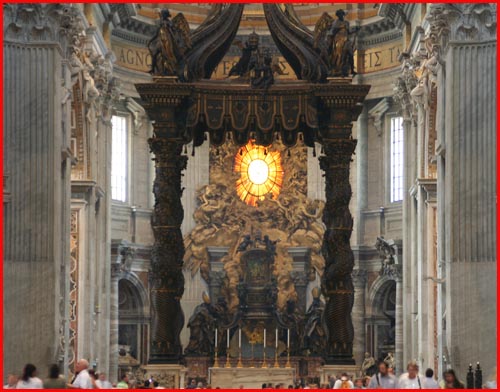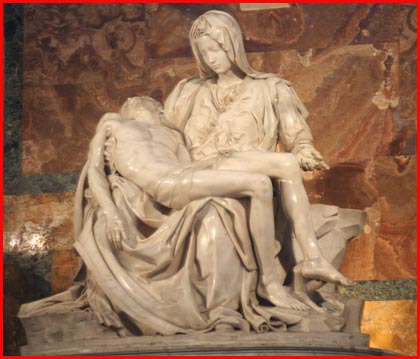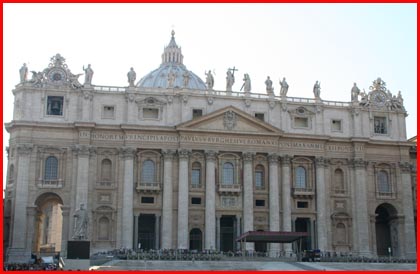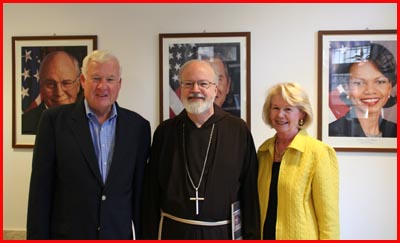Greetings bloggers. Welcome�.and thank you for visiting.
To begin today�s post, I wish to ask you to recall that today is the Feast of St. Michael, the Archangel. On this day, especially, we are very mindful of the fact that he is the patron of public safety. Today we are reminded to keep in our prayers members of the police and fire departments, as well as all public safety workers, in Boston, New England, the United States and all over the world�.these are the very courageous men and women who risk their lives for our safety and we are grateful for their caring and tireless work.

I�d like to share with you some reflections of Saint Peter and also share some thoughts and images of the magnificence that is St. Peter�s Basilica.
St. Peter, for Catholics, has such important meaning because of his role in the history of salvation. When you read the New Testament, one will find that after the name of Jesus, the name of St. Peter is the one that appears the most. He is the one that Jesus chose to be the head of the Apostles and he told Peter to “confirm your brethren in the faith.” So Peter�s role has been just that � to be the one who confirms us in our faith and maintains the unity of the Church.
Peter came to Rome, which in those days was the capitol of the known world, the European world and the Mediterranean world. As Bishop of Rome, Peter died here as a martyr in the Circus of Nero at the time of a very terrible persecution of the Church. He was buried near where he was martyred. His grave became a place of pilgrimage for Christians.
Constantine, when he was converted, built a huge Basilica – dedicated in 326 – on top of Peter’s grave and later on, Pope Julius decided that he was going to build a bigger Basilica at the time of the Renaissance. He took down the old Basilica and began work on the present Basilica, which was finished 100 years after he began. Michelangelo did most of the architecture, himself.
To me one of the most significant tours for anyone who comes to Rome, is to visit what is called the Scavi, the excavations underneath St. Peter�s where you actually go down into what was the old Roman cemetery and to the tomb where Peter was buried. When you think, for two thousand years believers have come here to pray�kings and queens, peasants, saints and sinners all came�.people came here because it was the tomb of Peter.
Jesus had said to Peter, �upon this rock, I will build my Church.� The Church of St. Peter�s is built, literally, on the rock of Peter, whose name means �rock.�
The Church of St. Peter�s is a wonderful monument of Christendom. It�s not actually the Cathedral of Rome�St. John Lateran is the Cathedral of Rome, which is another church built by Constantine. St. Peter�s is certainly the one that is the most emblematic of the City of Rome.
For me personally�I think anybody who visits St. Peter�s is overwhelmed by the majesty and the grandeur and the sheer size of this Basilica. When you look up at the ceiling and you see the letters, it says, �Thou art Peter, and upon this rock I will build my Church,� and you realize that the letters are actually nine feet tall and they look so small from the floor. It gives you some idea of the proportion of the Basilica. This year they are celebrating the 500th Anniversary of the Dedication of St. Peter�s.
I feel especially recharged spiritually and moved when I enter St. Peter�s, especially when I am able to go there to celebrate Mass. Also, every five years, the Bishops come back to Rome and we all say Mass at the tomb of Saint Peter and make our report to the Holy Father. In a very spiritual way it�s a reminder of our connectiveness in the College of Bishops to the Holy Father, who has the ministry of Peter today. It really is a magnificent church and visiting it is a spiritual experience.

The Main Altar, located right above the tomb of St. Peter, is referred to as the Papal Altar. Usually only the Holy Father, or a delegate, may celebrate Mass on that Altar.

Covering the Papal Altar is the Baldacchino, which was created by Gian Lorenzo Bernini, the same very famous sculptor who created �The Ecstasy of St. Teresa� statue located in my Cardinatial Church, the Santa Maria della Vittoria.

This is a magnificent work of art, with its spiral columns holding the canopy over the Main Altar.

If you go down to where the excavations are, you actually get to the very place where St. Peter�s tomb is located…below the Papal Altar.

From the Basilica floor, under the main alter, you see a box that contains the palliums that Archbishops wear. You may notice that when I participate in ceremonies in Boston, in my own Archdiocese, I wear a vestment, which looks like a white band with black crosses on it – they are made out of wool. It represents, like the Good Shepherd, carrying the sheep on his shoulders. That box is kept above the tomb of St Peter. They are given to new Archbishops on the Feast of St. Peter every year.

The Altar of the Chair is located further back at the far end of St. Peter�s Basilica.�there is what looks like a huge chair. It is said, contained in that sculpture of the chair, there are the remains of a chair that St. Peter himself used when he was in Rome.

High above the Altar of the Chair, one will see an alabaster window, depicting the Holy Spirit – “The Window of the Holy Spirit.”

The Piet� is probably considered one of the most beautiful statues ever made, carved in 1499 by Michelangelo when he was only 24 years old. It depicts what we would call the XIV Station (14th), where Jesus is taken down off the Cross and laid in the arms of Mary. The first time I saw this statue was in 1964 at the World’s Fair in New York. It was brought over to be displayed at the Vatican Pavilion. As you can imagine, it was quite a sensation at the time. I�m sure hundreds of thousands of people went there to see it on display. It certainly is a very beautiful and moving statue.

If you look closely at a band around Mary�s neck, it is said that Michelangelo placed his name along the band�. it�s said to be the only piece that he ever signed. The statue was actually sculpted to be viewed from below. It was created from one piece of marble. Michelangelo would say that when he looked at a large piece of stone before he began his creative work, that he envisioned his desired creation and then he liberated the figures from the stone.

In addition to saying Mass in front of the Tomb of St. Peter, I often say Mass on the Altar of Blessed John XXIII.

The glass tomb of Blessed John XXIII, below the Chapel’s Altar

On the top of the fa�ade of St. Peter�s, one finds Jesus, John the Baptist and eleven of the Apostles. The Apostles represented on the facade, symbolizes that they are the visible face of the Church. The Church is built on the foundation of the Apostles. The Church is not made out of marble, brick, mortar, wood and glass, but rather it is comprised of women, men, girls and boys who are formed into a living holy edifice.

The obelisk in St. Peter�s Square would have been one of the last things that St. Peter would have seen himself before his martyrdom. It was the Circus of Nero in those days and although they have moved this towering piece slightly from where it was at that time, it basically was very close to where it is now. The Caesars brought many of the obelisks back from Egypt as trophies and many of them are located in the different squares in Rome, often in front of important churches. You can actually see Egyptian hieroglyphics on many of them. Presumably, these were made by the Pharaohs in Egypt. There is quite a collection of them here in Rome now. At the very top of the obelisk in St. Peter�s square, you can see the “Chigi Star,” in honor of Pope Alexander VII.

Christ directly over the main door, symbolizing that in order to enter into Christ, one must enter His Church.

Saint Bruno, founder of the Carthusian Order – known for their life of monastic prayer and solitude. They are the only religious order in the Catholic Church that has never been reformed.

Although they look small from the floor of St. Peter’s, these letters are actually each nine feet tall.

The names of Cathedrals from all over the world are placed on the floor of St. Peter’s, in spots that correspond to their sizes, measured from the Altar of the Chair. Here’s the spot that marks the Cathedral of the Holy Cross in Boston.

Fountain in St. Peter’s Square at dusk.
Today, we visited the American Embassy to Italy, accompanying a group from the Order of Malta from Boston who are here visiting Rome and will be attending the Mass on Sunday. They arranged for us to have a wonderful tour.

The group from Boston includes Bob and Sue Downing, Bob and Mary Doyle, Hap and Sue Redgate, Rosemary and Jack MacKinnon, and Connie and John McManmon. It was a joy to spend time with this group and we all appreciated the hospitality of staff members at the American Embassy in Italy.

Mary and Bob Doyle posing for a picture in the entrance to the Embassy.

Front of the United States Embassy to Italy.
That’s all for today. I hope you have a wonderful weekend. Until my next post�..
God Bless,
Cardinal Se�n
